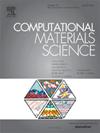Molecular dynamics study on the bubble nucleation characteristics of Cu-Ar nanofluids on groove surfaces with different wettability
IF 3.3
3区 材料科学
Q2 MATERIALS SCIENCE, MULTIDISCIPLINARY
引用次数: 0
Abstract
Although nanofluids demonstrate remarkable thermal properties as advanced heat transfer media, the synergistic effects of surface wettability and micro-groove structures on the bubble nucleation dynamics in nanofluids remain poorly understood. In this study, molecular dynamics simulations employing the Lennard-Jones potential function were utilized to investigate the bubble nucleation behavior of Cu-Ar nanofluids on surfaces with varying wetting grooves, thereby uncovering the underlying microscopic mechanisms. A comprehensive investigation was conducted to examine the bubble nucleation characteristics in nanofluids across four distinct surface configurations: 1. hydrophilic groove surface (surface #1), 2. hydrophobic surface at the bottom of the groove (surface #2), 3. hydrophobic surface on the side of the groove (surface #3), 4. hydrophobic groove surface (surface #4). The findings demonstrate that the presence of hydrophobic regions on grooved surfaces (Surface #2 and Surface #3) significantly diminished the impact of crystallized argon atoms on bubble nucleation, consequently enhancing the nucleation process. Notably, Surface #3 demonstrated the highest bubble growth velocity, achieving a nucleation time of merely 805 ps, which was approximately 20 % faster than the 1000 ps observed on Surface #1. Furthermore, the bubble nucleation temperature on Surface #3 reached a minimum of 97 K, indicating a 4.1 % decrease relative to the nucleation temperature on Surface #1. The nucleation mechanism on Surface #4 is distinct from other surfaces, characterized by the continuous vaporization of liquid argon atoms and their subsequent escape into the initial cavity, thereby facilitating bubble nucleation. These discoveries offer crucial theoretical foundations for the optimization of heat exchanger surface designs, thereby facilitating the improvement of heat transfer efficiency of nanofluids in devices operating under high heat flux conditions.

不同润湿性沟槽表面Cu-Ar纳米流体气泡成核特性的分子动力学研究
尽管纳米流体作为先进的传热介质表现出卓越的热性能,但表面润湿性和微槽结构对纳米流体中气泡成核动力学的协同作用仍知之甚少。在本研究中,采用Lennard-Jones势函数进行分子动力学模拟,研究了Cu-Ar纳米流体在不同润湿槽表面上的气泡成核行为,从而揭示了潜在的微观机制。通过四种不同的表面结构,对纳米流体中的气泡成核特性进行了全面的研究:2.亲水性沟槽表面(表面#1)2 .沟槽底部疏水表面(表面#2);4.沟槽侧面疏水表面(表面#3)。疏水槽表面(表面#4)。结果表明,沟槽表面(表面#2和表面#3)疏水区域的存在显著降低了结晶氩原子对气泡成核的影响,从而增强了成核过程。值得注意的是,表面#3显示出最高的气泡生长速度,实现的成核时间仅为805秒,比表面#1观察到的1000秒快了大约20%。表面3的气泡成核温度最低达到97 K,比表面1的成核温度降低了4.1%。表面4的成核机制与其他表面不同,其特点是液态氩原子不断汽化,随后逃逸到初始腔中,从而促进气泡成核。这些发现为优化换热器表面设计提供了重要的理论基础,从而促进了在高热流密度条件下运行的设备中纳米流体的传热效率的提高。
本文章由计算机程序翻译,如有差异,请以英文原文为准。
求助全文
约1分钟内获得全文
求助全文
来源期刊

Computational Materials Science
工程技术-材料科学:综合
CiteScore
6.50
自引率
6.10%
发文量
665
审稿时长
26 days
期刊介绍:
The goal of Computational Materials Science is to report on results that provide new or unique insights into, or significantly expand our understanding of, the properties of materials or phenomena associated with their design, synthesis, processing, characterization, and utilization. To be relevant to the journal, the results should be applied or applicable to specific material systems that are discussed within the submission.
 求助内容:
求助内容: 应助结果提醒方式:
应助结果提醒方式:


